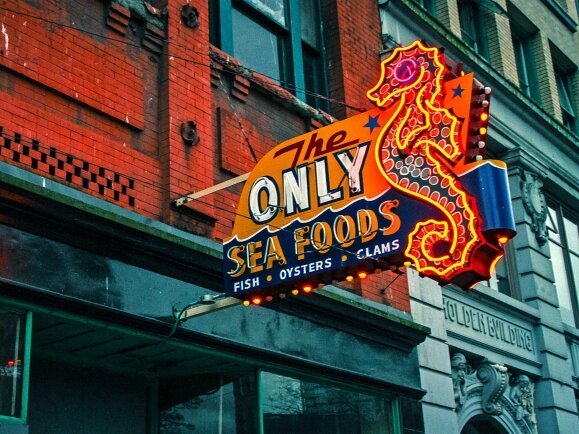The Only Seafood

Originally named “Nic & Gus” after owner Nic Thodos when it opened in 1923, the most popular place for fish on Hastings Street became The Only in 1924. Thodos’ sons, Peter and Constantine, would later run the 20-seat restaurant. Generations of adoring customers kept the restaurant alive until 2009.
“I remember the cook in there was this big guy. I just loved to watch him cook because it was very simple, and it was just amazing. Anytime I had friends coming in from San Francisco and elsewhere, I’d take ‘em over there. You knew that if you wanted good fish, that’s where you’d go. ”-Jim Wong-Chu, Chinatown historian
The PHS Community Services Society, a Downtown Eastside non-profit, has purchased the site. Plans are afoot to re-light the iconic seahorse neon sign and resurrect The Only as a social enterprise.
 Read
Read
“It was very simple, right? I mean, it’s just fish. And you put in flour, and you’ve got to pan fry, deep fry, and so on. But it was just amazing. The bread they got was from this place called the Swiss Bakery. And it was some of the very best bread.
Their black cod was famous. I’d go there quite often and in fact, anytime I had friends coming in from San Francisco and elsewhere, I’d take ‘em over there. A lot of funky people, a lot of rock stars and so on, they’d finish nights here when it was still going. People would go and have their fish there.
You knew that if you wanted good fish, that’s where you’d go. But, eventually, it just got crowded out. And it wasn’t viable anymore.”
CLOSE FULL STORY— Jim Wong-Chu, Chinatown historian, former Only patron
 Read
Read
“The Only is so good because it’s an extraordinarily good example of the sign bender’s art because you have two things going on: you have an artist who understands that you need a sign in the daylight, and you need a sign in the nighttime. And the two signs are different.
The painted sign is actually just a rather good piece of work in terms of colour, and composition, and everything else. The nighttime sign is brilliant because it throws you off because it’s an orange seahorse.
But when you look closely, that sign bender has actually bent the orange neon and then brought it around, and there’s a ruby red eyeball that’s welded in to the tube, so that’s a nice complicated piece of bending and then you’ve got the contrast of the green with the letters and the seafood.
The original sign was red and yellow light bulbs that sort of flickered around the rim so you’ve got all this activity, plus brilliant colours. It’s a very simple sign, but it’s quite an iconic sign that works.”
CLOSE FULL STORY— John Atkin, civic historian

















